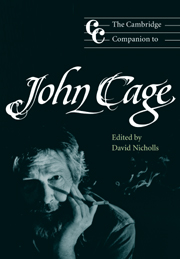2 - Cage and Europe
from Part I - Aesthetic contexts
Published online by Cambridge University Press: 28 September 2011
Summary
John Cage was an American original. His inventiveness, which he claimed as originating from his father, has an “American-ness” that has a long history, dating back to the very beginnings of European migration to the “new world.” Historian Brooke Hindle asks, “how could the custodians of an empty continent, far distant from the economic power centers of Europe and from its busy workshops and rising factories, move on to take leadership in one line after another of mechanization and innovation?” (Hindle 1981, p. 3). While that question requires an entire book for Hindle to answer, by the time Cage was writing music, the notion that the United States was an important source of newness, innovation and invention was well established. Cage's sense of invention–whether it be the discovery of new sounds through percussion or the creation of the prepared piano in the 1930s and 1940s, or the more (in)famous explorations into chance and indeterminacy in the 1940s and 1950s – is the stuff of legend and, as well, the very things most strikingly not European in Cage's work.
Other so-called American originals intentionally grounded their work in a way that differentiated it from Europe. Authors that later became especially influential to Cage, Ralph Waldo Emerson and particularly Henry David Thoreau, saw themselves as writing a way out of European influence. Emerson wrote, “It is for want of self-culture that the superstition of Travelling, whose idols are Italy, England, Egypt, retains its fascination for all educated Americans” and “why need we copy the Doric or the Gothic model?
- Type
- Chapter
- Information
- The Cambridge Companion to John Cage , pp. 20 - 40Publisher: Cambridge University PressPrint publication year: 2002
- 9
- Cited by



